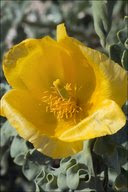

Gláucia - flor amarela que cresce nos terrenos arrenosos da Europa
e Norte Americanos.
Existem várias flores do genero: Glaucium ,
que pertence a Familia: Papaveraceae (Papoulas) .
Uma comumente encontrada e a flor Glaucium flavum, foto.
According to W. R. Ernst (1962b), Papaveraceae "may be divided conveniently into four subfamilies." His scheme is followed here, but with the subfamilies taken up in alphabetic order; they seem to be natural groups, but their phylogenetic interrelationships are not yet clear. Similarly, the evolutionary relationships within the subfamilies remain ambiguous, and the genera in each are listed alphabetically. Subfamily Chelidonioideae Ernst includes genera 1-5; subf. Eschscholzioideae Ernst, genera 6-7; subf. Papavaroideae Ernst, genera 8-14; and subf. Platostamenoideae Ernst, genera 15-17.[1]
De acordo com a WR Ernst (1962b), Papaveraceae "pode ser dividido convenientemente em quatro subfamílias." Seu esquema é seguido aqui, mas com as subfamílias tomadas em ordem alfabética, pois eles parecem ser os grupos naturais, mas suas inter-relações filogenéticas ainda não estão claras. Do mesmo modo, as relações evolutivas dentro do subfamílias permanecem ambíguos, e os gêneros em cada estão listados em ordem alfabética. Subfamília Chelidonioideae Ernst inclui géneros 1-5; subf. Eschscholzioideae Ernst, gêneros 6-7; subf. Papavaroideae Ernst, gêneros 14/08 e subf. Platostamenoideae Ernst, gêneros 15-17.
Taxonomy[ Back to top ]
•Domain: Eukaryota () - Whittaker & Margulis,1978 - eukaryotes
•Kingdom: Plantae () - Haeckel, 1866 - Plants
•Subkingdom: Viridaeplantae () - Cavalier-Smith, 1981
•Phylum: Tracheophyta () - Sinnott, 1935 Ex Cavalier-Smith, 1998 - Vascular Plants
•Subphylum: Euphyllophytina ()
•Infraphylum: Radiatopses () - Kenrick & Crane, 1997
•Class: Magnoliopsida () - Brongniart, 1843 - Dicotyledons
•Subclass: Ranunculidae () - Takhtajan Ex Reveal, 1992
•Superorder: Ranunculanae () - Takhtajan Ex Reveal, 1992
•Order: Papaverales () - Dumortier, 1829
•Family: Papaveraceae () - Adans., 1763, Nom. Cons. - Poppy Family
•Genus: Glacium ()
•Specific epithet: flavum - Crantz
•Botanical name: - Glacium flavum Crantz
Notes
Name Status: Accepted Name . Latest taxonomic scrutiny: 07-Oct-1996
Glacium flavum Crantz., 1763
Synonyms: None
Common names: Engl: Yellow horned-poppy;
Nome comum : Inglaterra: Chifres de papoula amarelo.
Order: PAPAVERALES
Family: PAPAVERACEAE
Taxonomic descriptions: Annual, biennial or perenial herb 20-50 cm in height. Stem is bluish and fleshy. The lower leaves have thick hairs. Flowers are large, yellow, with 4 petals like a poppy. Fruit is a pod up to 25 cm length.
Descrição taxonômica: anual, bienal ou perene erva 20-50 cm de altura. Caule é azulado e carnudas. As folhas mais baixas têm pêlos grossos. As flores são grandes, amarelo, com quatro pétalas, como uma papoula. Fruto é uma vagem de até 25 cm de comprimento.
IUCN Status:
World level: NE
Black Sea Regional level: VU
Subregion level: VU (Ukraine)
Status IUCN:
Nível mundial: NE
Black Sea nível Regional: VU
Sub-nível: VU (Ucrânia)
Distribution:
Habitats type, Critical habitats, Limiting factors: Coastal sands and shingles.
Biology: Flowering during V-VII, fruit-bearing - VII-IX. Reproducing by seeds.
Population trends: Occurs rarely, in little groups. Populations are stable (100-130 specimens).
Threats: Destroying ecotops, while improving beaches, high recreational loading and the medical value of the species.
Conservation measures taken: No special protection.
Conservation measures proposed: To create protected zones in places where it occurs.
Distribuição:
Habitats, digite habitats críticos, Fatores limitantes: areias costeiras e as telhas.
Biologia: Floresce durante a V-VII, a dar frutos - VII-IX. Reprodução por sementes.
Tendências da população: ocorre raramente, em pequenos grupos. Populações são estáveis (100-130 indivíduos).
Ameaças: A destruição de ecótopos, melhorando praias, alta carga de recreio eo valor medicinal da espécie.
Medidas de conservação adoptadas: Sem proteção especial.
As medidas de conservação propostas: Para criar zonas protegidas em locais onde ela ocorre.
References:
Red Data Book of Bulgaria. Vol. 1. Plants. - Sofia, 1984.
Red Data Book of Russian Soviet Federal Socialist Republic. Plants. - Moscow, 1988. - 590 p.
Red Data Book of Ukraine. Vegetable Kingdom. - Kyiv, 1996. - 606 p.
Compiled by: S.Dyatlov, T.Vasilieva
Referências:
Red Data Book da Bulgária. Vol. 1. Plantas. - Sofia, 1984.
Red Data Book da Rússia República Socialista Soviética Federativa. Plantas. - Moscou, 1988. - 590 p.
Red Data Book da Ucrânia. Reino vegetal. - Kyiv, 1996. - 606 p.
Elaboração: Dyatlov S., T. Vasilieva
Bibliografia - Further Reading
•Ernst, W. R. 1962. A Comparative Morphology of the Papaveraceae. Ph.D. dissertation. Stanford University.
•Ernst, W. R. 1962b. The genera of Papaveraceae and Fumariaceae in the southeastern United States. J. Arnold Arbor. 43: 315-343.
•Ernst, W. R. 1967. Floral morphology and systematics of Platystemon and its allies Hesperomecon and Meconella (Papaveraceae: Platystemonoideae). Univ. Kansas Sci. Bull. 47: 25-70.
•Fedde, F. 1936. Papaveraceae. In: H. G. A. Engler et al., eds. 1924+. Die natürlichen Pflanzenfamilien, ed. 2. 26+ vols. Leipzig and Berlin. Vol. 17b, pp. 5-145.
•Fedde, F. 1909. Papaveraceae-Hypecoideae et Papaveraceae-Papaveroideae. In: H. G. A. Engler, ed. 1900-1953. Das Pflanzenreich. 107 vols. Berlin. Vol. 40[IV,104], pp. 1-430.
•Grey-Wilson, C. 1993. Poppies: A Guide to the Poppy Family in the Wild and in Cultivation. Portland.
•Gunn, C. R. 1980. Seeds and fruits of Papaveraceae and Fumariaceae. Seed Sci. Techn. 8: 3-58.
•Gunn, C. R. and M. J. Seldin. 1976. Seeds and Fruits of North American Papaveraceae. Washington. [U.S.D.A. Agric. Res. Serv., Techn. Bull. 1517.]
•Harms, H. 1936. Reihe Rhoeadales. In: H. G. A. Engler et al., eds. 1924+. Die natürlichen Pflanzenfamilien, ed. 2. 26+ vols. Leipzig and Berlin. Vol. 17b, pp. 1-4.
•Hutchinson, J. 1925. Contributions towards a phylogenetic classification of flowering plants: V. The genera of Papaveraceae. Bull. Misinform. Kew 1925: 161-168.
•Kadereit, J. W. 1993. Papaveraceae. In: K. Kubitzki et al., eds. 1990+. The Families and Genera of Vascular Plants. 2+ vols. Berlin etc. Vol. 2, pp. 494-506.
•Stermitz, F. R. 1968. Alkaloid chemistry and the systematics of Papaver and Argemone. Recent Advances Phytochem. 1: 161-183.

